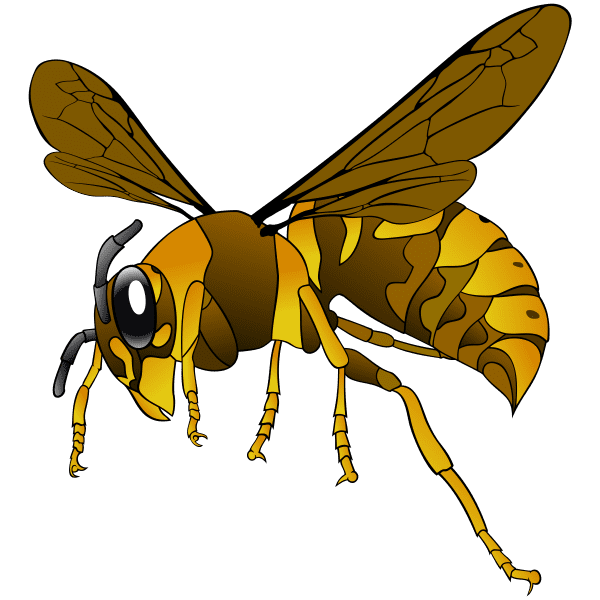Last Updated on May 9, 2023 by
Depending on their surroundings, different species also specialize in various diets and hunting methods. Because they hunt and paralyze their prey before feeding their developing larvae this fresh food, some species are parasites. What Do Wasps Eat? You are probably most familiar with yellow jackets and hornets, which belong to the family Vespidae, a social group of wasps. At this point, approximately 30,000 species of wasps have been identified. There are only 1000 species of social wasps among these, vastly outnumbering the solitary group.
Table of Contents
Types of Wasps
Public Wasps
They can be problematic because wasps will vigorously defend their nests when they sense danger, resulting in painful and occasionally fatal stings for animals or people who get too close. Social wasps often have bright colors on them, which is a defense mechanism that tells predators to stay away unless they want to be poorly stung! A queen wasp will construct a nest each spring and produce a brood of female workers. After that, she goes into hibernation and waits until spring to start a new colony. The workers look after the queen, who is always busy expanding the nest and laying eggs to grow the colony.
Isolated Wasps
Although some of these wasps construct individual nests, they do not form colonies. In contrast to social wasps, solitary wasps tend to use the stingers’ venom to hunt prey rather than defend themselves, even though some of them also have stingers. Solitary wasps are frequently parasitic as well as the majority of these females construct an underground nest and lay single eggs in cells. The female hunts for prey; typically, other insects paralyze them and place them in the nest for the larvae to consume when they hatch. It’s horrible, but it works! Lone wasps additionally bite up the wood mash and other plants and spew them to frame papery cells inside their homes. These protect individual eggs that are laid inside. A wasp’s diet is heavily influenced by its species and the environment in which it lives.
Spider Wasp
Wasps that specialize in spider hunting are spiders. This group uses a wide range of stinging and paralyzing methods, but they typically only sting the spiders in one or two places, resulting in complete paralysis.
Cuckoo Wasp
Even though it doesn’t look like a wasp at all, this solitary wasp subgroup is enormous and diverse! They typically have metallic green or blue colors and are relatively small. The cuckoo wasps’ egg is not noticed by the host species’ adults, who carry on, as usual, sealing the egg chamber and feeding the larvae once they hatch. Cuckoo wasp larvae, on the other hand, will out-compete the larvae of their host species by either eating them directly or consuming all of the food that is provided.
Scoliid Wasp
The larvae of soil-dwelling scarab beetle species are parasitized by Scoliid wasps, which are typically brightly colored and quite large. The female beetle will either scurry down an existing tunnel or dig into the soil to locate the larva. She will sting the larva, paralyze it, and lay an egg directly on it once she is found.
On the other hand, she will drop further down into the dirt, carrying the deadened hatchling alongside her, and she will store it close by her egg in another chamber. The Scoliid wasp larva feeds on the live beetle larva for a few weeks after hatching.
What do wasps eat?

Social wasps such as yellow jackets, red wasps, and hornets seek out and dissect other insects to provide food for their nesting larvae. They don’t care about protein and will eat anything, including:
- Caterpillars and Small insects like greenflies and whitefly
- Ants
- Beetles
- Crickets
- Mortal edibles
- Rubbish
- Dead bodies of plants and animals
- Grasshoppers
- Cicadas
- Insects having wings
Because of this, wasps are actually good friends with gardeners because they catch a lot of insects each year, many of which are considered pest species. So, the next time a wasp buzzes around your head and irritates or even scares you, remember that they protect your prized plants, fruits, and flowers!
In fact, wasps are used by the agriculture industry in many areas to prevent insects from ruining crops wasps can even be artificially used for this purpose. Additionally, when you have a picnic or grill outside, social wasps will buzz around looking for food. To collect and feed their larvae, the adults will be drawn to anything sweet or anything meaty. Additionally, some species of wasps consume fruit, particularly very ripe or rotting fruit. They are frequently found on overripe blackberries or fallen apples in the fall. They might even get drunk if they eat fermented fruit! Wasps can be more aggressive when intoxicated, so it’s best to avoid fermenting fruit.
Features that influence the edibles of wasps
- Wasps consume food at different rates depending on many ways. The weather is one factor.
- During the warmer months, wasps are more active and consume more frequently. During the warmer months, wasps consume a more significant number of insects.
- Some wasps go into hibernation over the winter, while others die. Age is another factor that influences how frequently wasps consume food.
- The majority of the wasp larvae are carnivorous, which may be related to their requirements for growth.
- Compared to their adult counterparts, these organisms typically consume protein more frequently to maintain growth and development.
- Because mosquitoes do not contain any protein in their larvae, it makes sense from a logical standpoint for wasps not to target them.
- Wasps, on the other hand, would devote time and effort to searching for crab spiders and tiny caterpillars for more nutritious food.
- In their role as prey, various organisms, including mammals, reptiles, insects, and birds, prey on them.
- In this sense, wasps enable these creatures to survive by providing an excellent source of nutrition.
- Wasps regulate the local population of the insects they eat, like spiders, by acting as predators.
Conclusion
The diet of a wasp depends on whether it is an adult or a larva: adults only consume sugary foods like honeydew and nectar. While larvae consume meat and insects for their high protein content. Numerous larvae are housed in the papery nests that social wasps construct in their colonies. Solitary wasps construct their nests and lay their eggs in papery egg cells. They frequently act as parasites, capturing and bringing specific insect prey back to the nest (alive!). Then they paralyze it to provide the larvae with food.
Although wasps do not technically consume wood, they do collect it for use in building their nests and egg cells by ingesting it and regurgitating it. Wasps contribute significantly to the biodiversity of the ecosystems in which they are found. They benefit humans by preventing the overwintering of pest insects in our crops and gardens. We hope that now you know more about how wasps work and how they eat. You will be able to appreciate their essential role and lessen their fearsome reputation. The wasps are fantastic.
Apart from this, if you are interested to know more about how to Get Rid of Spiders in Australia then visit our Lifestyle category.
FAQs
To survive, nectar and pollen are required by all adult wasps. It is necessary for the wasps to survive because it is high in protein (up to 61%). Wasps can consume flowers’ nectar and other sweet liquids thanks to a unique mouthpart.
It shifts according to the season. Wasp grubs consume insect prey brought in by foraging workers, requiring a diet primarily composed of protein. Since the workers primarily require energy from foods like carbohydrates, they favor nectar and sweets like fresh and processed fruits.





















